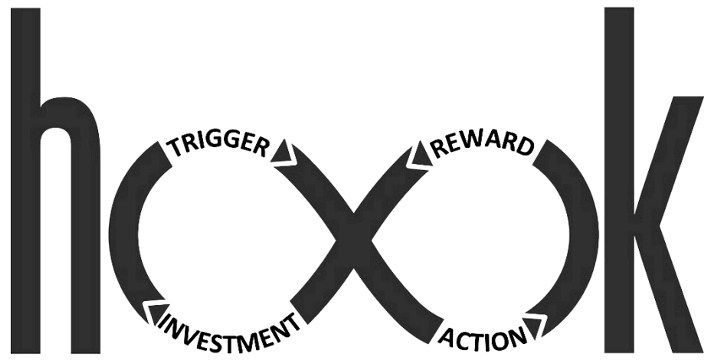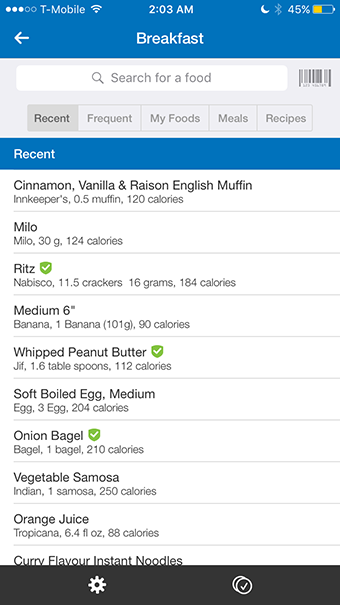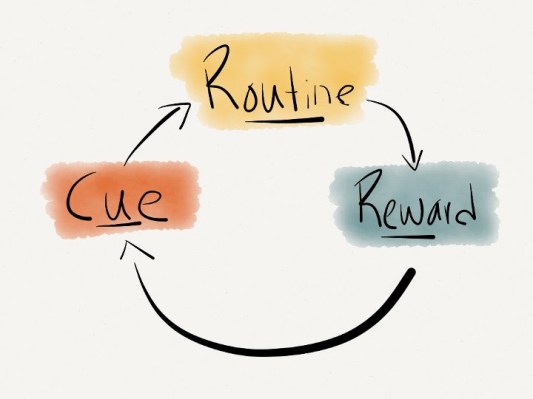Meet Joe. He’s in his mid 30s and has two kids. Trying to watch his waistline, he decides he wants to lose 20 pounds. He buys the latest in wearables and the best in fitness apps to track his food and exercise. He tracks religiously for the first week and manages to lose a few pounds.
But by week two, he’s less excited. And by the end of the month, he completely stops and he gains back the pounds. He’s unhappy about how he looks, and blames himself for failure.

So, why is it so hard for Joe to change his behaviours? Because 45 percent of the decisions we make each day are habits, which we do without much thought.
Cues, such as boredom, hunger, an activity, a time or an emotion trigger us to do certain actions or routines. When we complete that routine, we get a physical or an emotional reward. Doing this often enough gets us into a habit-forming loop.

Let’s take look at Joe again. Say Joe wants to go to the gym after work.
But when he gets home (cue), he sits in front of the TV (routine) and he feels happy and relaxed (reward). By having repeated this cycle every day, Joe associates the cue of coming home to watching TV and feeling relaxed. This pattern becomes etched in his neural pathway, becoming a hardwired habit over time. That is why it is so hard for Joe to change his habits.
Changing habits is possible, but it takes conscious and repeated effort. And technology can help.
Technology has the ability to engage with users on an intimate level. As designers of technology, we have the opportunity to influence our users, beyond just prompting new behaviours. Done right, our products have the potential to promote and reinforce positive long term habits.
Using Nir Eyal’s Hooked model as a framework, I will take a deep dive into how we can build products that shape user habits, and see some of those principles in action in existing healthcare apps.
Hooked model
Nir Eyal’s Hooked Model on habit-forming products can help us design solutions that change user behaviour and increase engagement with an app.

The Hooked Model states that in order for habits to be formed, the user needs to be sent a trigger that then leads to an action (the habit we want to form). When the user takes action, a reward encourages them to repeat the action in the future.
By repeating the action multiple times, the user starts to invest in your product.
Getting users through the Hook cycles again and again helps users form habits and increase their long-term engagement with the product.
Triggers

When starting to form new habits, triggers often come from the product itself. This could be in the form of emails, notifications, SMSes, vibrations to your wearable, etc.
As designers, we often pay little attention to notifications: It’s more of an afterthought to the products we design. However, triggers are the key in getting users to even open the app.
In order to be effective, a trigger must be timely, intriguing and actionable.

Timely. Triggers need to occur at a moment when the user is most likely to take an action. Sending a user a notification to weigh in at 3 p.m. is not as effective as an early-morning reminder.
Nike’s FuelBand is a great example of timely triggers.

With “Win the Hour,” Nike encourages you to be more active. Every hour of the day, you’ll get a reminder to move for five minutes consecutively and “win” the hour. It encourages you to take an immediate action, serving as an excellent trigger.
Intriguing. Users are flooded with notifications every day, and there is a big competition to get noticed. Intriguing triggers are a way to rise above the noise.
MyFitnessPal, an exercise and food tracker, uses repetitive notifications to remind you to take action. CarrotFit, which is also an exercise and food tracker, uses mean (and funny!) and varied notifications to encourage action.

Actionable. Most importantly, triggers need to be actionable. Without a direct call to the target action, triggers are less effective in forming habits.
At the end of every week, Fitbit emails users a summary of their weekly performance and how they compared to their previous week’s performance.

Since users don’t even need to log in to see their stats, this email can motivate inactive users. However, the email does not contain clear calls to actions on what the user should do next. Without clear calls to actions, Fitbit is leaving it up to the hands of their users to decide what to do.
Providing clear calls to actions in your triggers can be extremely effective in both user engagement and performance. Shapeup uses simple calls to actions such as “Park further away” and “Take the stairs instead of the elevator” in its performance emails to double the amount of weight lost by their users.
Intrinsic triggers
While timely, intriguing and actionable triggers are important to get a user to take an action, in order to create repetitive habits, the triggers need to come internally from the user themselves.
Positive emotional responses (e.g. need to belong, satiating boredom) and negative emotional responses (e.g. boredom, loneliness, depression, anger) are the most powerful motivators to forming habits.

Users form habits by associating a strong emotional response with your product during each use. To elicit strong emotional responses, we need to identify what a user’s pain point is and aim to solve it.
To do this, Nir Eyal recommends the 5 Whys method. The general idea is to keep asking Why until you manage to hit an intrinsic pain point.
Let’s take a look at Joe and Jessica, both of whom have purchased a wearable.

Both Joe and Jessica want to track their movements and exercises. But as we keep asking why, we realise that their intrinsic motivation for purchasing the wearable is different.
Products fail to create habits when they use blanket triggers for users with different intrinsic motivations. The triggers are never internalised, as they aren’t targeting the right pain points.
By grouping users based on their intrinsic motivations, we can now send highly specific notifications.
For users whose primary need is for approval, notifications such as “Looking good” and “You’re doing a great job” could be used. OneDrop, a diabetes management app, uses positive notifications to keep users motivated.

For users whose primary need is for admiration, notifications such as “You’re crushing the competition today” and “You nailed it” can be effective.
Targeted triggers promote more action, and through repeated usage, users associate an emotional response to your product. That becomes an internal trigger that prompts future interaction and engagement with the app.
Actions

Triggers alone are not enough in order to get a user to take an action. We need to also understand the user’s motivation and abilities to take those actions.
Fogg’s Behavioral Model (FBM) states that motivation to do a task and the ability to do a task have a strong effect on whether someone will take an action.

The FBM states that, as long as someone is above the action line, a trigger is likely to succeed at eliciting the action. When a person has low ability and low motivation, triggers will not work. If a user is injured, and not particularly interested in running a marathon, no amount of triggers will be able to get him to go for a run.
FBM is predicated on trying to get users to go above the activation threshold, which can be accomplished by either increasing their motivation or their ability.
Increasing motivation
There are a couple of ways to increase motivation. People are highly motivated by one of these three factors:
Increasing Pleasure / Decreasing pain:

Nike’s Fuelband uses little LEDs on the band to indicate the amount of progress you’ve made for the day. The coloured indicators serve as a way to increase the user’s motivation by increasing the pleasure they received from leveling up till the end.
The Pact app gets users to make pledges on their goals for the week. So users pledge that they will lose $X each time they fail to complete a pledge. Losing money simulates high levels of pain in the brain. Pactapp tries to motivate its users by reducing the pain of losing money.

Hope/Fear:
Another way to motivate users is through providing hope or alleviating fear. When users anticipate something good will happen, the hope motivates them to take the action. MyFitnessPal uses the hope of being able to reach your goal for the day as a trigger to encourage you to take more steps.

Social acceptance/Rejection:
Being social creatures, social acceptance and rejection are really powerful ways to increase motivation. Fitocracy does an excellent job of providing social acceptance. The community is a big part of their offering. So when a user completes an activity on Fitocracy, other users on the platform give them props and motivate them to keep going. This form of acceptance and approval, and feeling of being part of a community is a powerful motivator for users to keep using Fitocracy.

More than social acceptance, people are extremely motivated to avoid being excluded or ostracised from groups. In Nike groups, there is a tracker to show you how many other users have hit their goals for the group. This increases a user’s motivation to keep working out and hit their group goal and not let their group down.

Increasing ability
The way to increase ability is not through training or resources, but by making tasks simpler. That can be done through reducing the time taken, or the amount of physical or mental effort needed.
For example, MyFitnessPal shows you a whole list of your previously added meals, helping you track food in one click, instead of having to search or enter the information again. By simplifying that food tracking process, MyFitnessPal increases the user’s ability, making it more likely that they will track their food intake.

Understanding users’ motivations and abilities and designing appropriate triggers is only half the battle. Triggers can help users take an action and engage with your app. But their experience after taking that action is crucial in deciding if the user will even want to take that action again or not.
In order to create habit forming products, we also need to understand how users are rewarded for taking certain actions and how we can tweak those rewards to get users to repeat that action.
